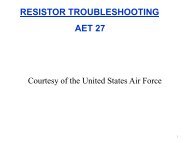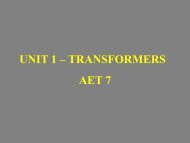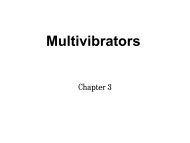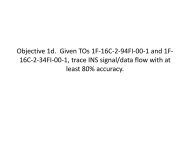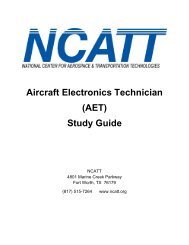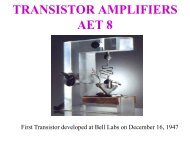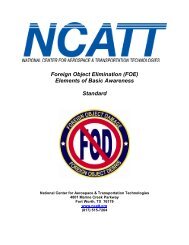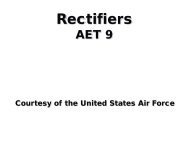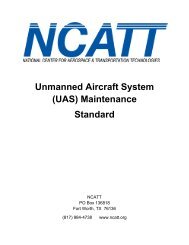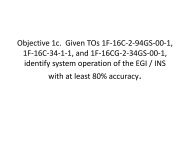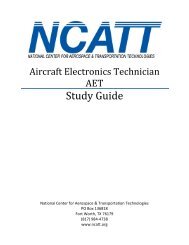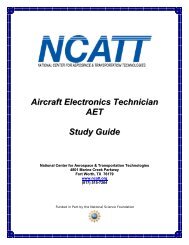Foreign Object Elimination Elements of Basic Awareness ... - NCATT
Foreign Object Elimination Elements of Basic Awareness ... - NCATT
Foreign Object Elimination Elements of Basic Awareness ... - NCATT
Create successful ePaper yourself
Turn your PDF publications into a flip-book with our unique Google optimized e-Paper software.
Page 11 <strong>of</strong> 16<br />
Instructional Content:<br />
• Report Missing, Lost and Found Items—This is an integral part <strong>of</strong> having a successful FOD Program<br />
and all technicians are encouraged and responsible to report missing, lost or found items. Typically<br />
there is a documented process <strong>of</strong> steps that are to be followed, and is designed to ensure employees<br />
will report lost items before they cause damage. At most facilities there are NO repercussions for<br />
reporting a lost or missing tool or item even if the technician is at fault. Although established as a<br />
positive self reporting method, repeat <strong>of</strong>fenders may face disciplinary action.<br />
• If an item is lost during an assembly, manufacturing, or maintenance task, cease activity in the<br />
affected area and initiate a search for the item. Continue this search until the item is found or adequate<br />
assurances are made that the item is not contained in the aircraft, aerospace vehicle or assembly.<br />
Searching for such items may require de-paneling or nondestructive inspections, including flashlight<br />
and mirror, borescope and x-ray. If an item cannot be located after a search has been completed,<br />
annotate the applicable forms with a description <strong>of</strong> the item and the search procedure that was<br />
followed.<br />
Student <strong>Object</strong>ive:<br />
The student will identify the relationship <strong>of</strong> basic facts and state general principles about:<br />
• Reporting lost, missing or found items<br />
• The processes used to locate missing items, and follow-up requirements for missing items that are not<br />
found<br />
Standard #6 - Physical Entry & Personnel Control<br />
<strong>NCATT</strong> Training Standards Level (B)<br />
Equivalent FAA Part 147 Level (2)<br />
Instructional <strong>Object</strong>ive:<br />
Identify the relationship <strong>of</strong> basic facts and state general principles about physical entry into both flight hardware<br />
and FOD Designated Areas.<br />
Instructional Content:<br />
• General Entry—When physical entry is required into flight hardware (e.g., crew compartment, engine<br />
intake, exhaust, fuel tank areas, etc.) personnel should remove all loose objects, badges, jewelry, etc.,<br />
from clothing. Pocketless or closed zippered pocket coveralls should be worn to preclude foreign<br />
objects dropping from pockets.<br />
• Designated Areas—A FOD Designated Area is any area where flight hardware is in place and<br />
exposure to foreign objects would potentially cause a system or product failure due to deterioration,<br />
malfunction or damage.<br />
• Most manufacturing companies identify FOD Designated Areas based on a risk assessment <strong>of</strong> the<br />
potential for FO to migrate into the final product. Requirements for entry into and working within<br />
these areas increase as the final product progresses through the factory to customer delivery.<br />
• FOD Designated Areas whether found in manufacturing operations, repair station or general repair<br />
facilities, are selected and defined by the individual aerospace operator in accordance with their<br />
particular operational requirements. FOD Designated Areas are typically identified as: FOD<br />
Copyright © 2009 by the National Center for Aerospace & Transportation Technologies. All rights reserved.<br />
Individuals may download, print, and make copies <strong>of</strong> this document<br />
for their own personal use. Commercial use prohibited.




